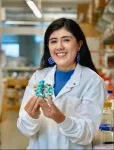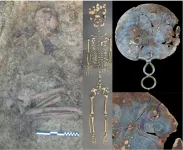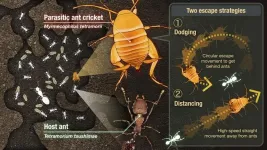(Press-News.org) New proteins not found in nature have now been designed to counteract certain highly poisonous components of snake venom. The deep learning, computational methods for developing these toxin-neutralizing proteins offer hope for creating safer, more cost-effective and more readily available therapeutics than those currently in use.
Each year more than 2 million people suffer snakebites. More than 100,000 of them die, according to the World Health Organization, and 300,000 suffer severe complications and lasting disability from limb deformity, amputation or other aftereffects. Sub-Saharan Africa, South Asia, Papua New Guinea, and Latin America are among the places where poisonous snakebites pose the greatest public health concern.
The computational biology effort to discover better antivenom therapeutics, led by scientists at the UW Medicine Institute for Protein Design and the Technical University of Denmark, is reported today, Jan. 15, in Nature.
The lead author of the paper is Susana Vazquez Torres of the Department of Biochemistry at the UW School of Medicine and the UW Graduate Program in Biological Physics. Her hometown is Querétaro, Mexico, which is located near viper and rattlesnake habitats. Her professional goal is to invent new drugs for neglected diseases and injuries, including snakebites.
Her research team, which also included international experts in snakebite research, drugs and diagnostics, and tropical medicine from the United Kingdom and Denmark, concentrated their attention on finding ways to neutralize venom gathered from certain elapids. Elapids are a large group of poisonous snakes, among them cobras and mambas, that live in the tropics and subtropics.
Most elapid species have two small fangs shaped like shallow needles. During a tenacious bite, the fangs can inject venom from glands at the back of the snake’s jaw. Among the venom’s components are potentially lethal three-finger toxins. These chemicals damage bodily tissues by killing cells. More seriously, by interrupting signals between nerves and muscles, three-finger toxins can cause paralysis and death.
At present, venomous snakebites from elapids are treated with antibodies taken from the plasma of animals that have been immunized against the snake toxin. Producing the antibodies is costly, and they have limited effectiveness against three-finger toxins. This treatment can also have serious side effects, including causing the patient to go into shock or respiratory distress.
“Efforts to try to develop new drugs have been slow and laborious,” noted Vazquez Torres.
The researchers used deep learning computational methods to try to speed the discovery of better treatments. They created new proteins that interfered with the neurotoxic and cell-destroying properties of the three-finger toxin chemicals by binding with them.
Through experimental screening, the scientists obtained designs that generated proteins with thermal stability and high binding affinity. The actual synthesized proteins were almost a complete match at the atomic level with the deep-learning computer design.
In lab dishes, the designed proteins effectively neutralized all three of the subfamilies of three-finger toxins tested. When given to mice, the designed proteins protected the animals from what could have been a lethal neurotoxin exposure.
Designed proteins have key advantages. They could be manufactured with consistent quality through recombinant DNA technologies instead of by immunizing animals. (Recombinant DNA technologies in this case refer to the lab methods the scientists employed to take a computationally designed blueprint for a new protein and synthesize that protein.)
Also, the new proteins designed against snake toxins are small, compared to antibodies. Their smaller size might allow for greater penetration into tissues to quickly counteract the toxins and reduce damage.
In addition to opening new avenues to develop antivenoms, the researchers think computational design methods could be used to develop other antidotes. Such methods also might be used to discover medications for undertreated illnesses that affect countries with significantly limited scientific research resources.
“Computational design methodology could substantially reduce the costs and resource requirements for development of therapies for neglected tropical diseases,” the researchers noted.
The senior researchers on the project to design protein treatments for elapid snakebites were Timothy J. Perkins at the Technical University of Denmark and David Baker of the UW Medicine Institute for Protein Design and the Howard Hughes Medical Institute. Baker is a professor of biochemistry at the UW School of Medicine.
The University of Washington has submitted a provisional U.S. patent application for the design and composition of the proteins created in this study.
END
Deep learning designs proteins against deadly snake venom
The approach holds potential for creating safer, cost-effective and more readily accessible antivenoms
2025-01-15
ELSE PRESS RELEASES FROM THIS DATE:
A new geometric machine learning method promises to accelerate precision drug development
2025-01-15
Proteins are the foundation of all life we currently know. With their virtually limitless diversity, they can perform a broad variety of biological functions, from delivering oxygen to cells and acting as chemical messengers to defending the body against pathogens. Furthermore, most biochemical reactions are only possible thanks to enzymes, a special type of protein catalysts.
The molecular surface of proteins is the key to their function, such as docking small molecules or other proteins or driving ...
Ancient genomes reveal an Iron Age society centred on women
2025-01-15
An international team of geneticists, led by those from Trinity College Dublin, has joined forces with archaeologists from Bournemouth University to decipher the structure of British Iron Age society, finding evidence of female political and social empowerment.
The researchers seized upon a rare opportunity to sequence DNA from many members of a single community. They retrieved over 50 ancient genomes from a set of burial grounds in Dorset, southern England, in use before and after the Roman Conquest of AD 43. The results revealed that this community was centred around bonds of female-line descent.
Dr Lara Cassidy, Assistant Professor in Trinity’s Department of Genetics, led ...
How crickets co-exist with hostile ant hosts
2025-01-15
Researchers at Nagoya University in Japan have discovered sophisticated behavioral strategies that enable parasitic crickets to survive within ant colonies. Led by Ryoya Tanaka, the team documented how these insects successfully navigate life among potentially lethal hosts through precise evasion tactics. Their findings, published in Communications Biology, reveal remarkable adaptations that allow these cricket species to thrive in a hostile environment.
Animals that live in ant colonies, known as “ant guests”, exploit their hosts’ resources. However, this ...
Tapered polymer fibers enhance light delivery for neuroscience research
2025-01-15
WASHINGTON — Researchers have developed a reliable and reproducible way to fabricate tapered polymer optical fibers that can be used to deliver light to the brain. These fibers could be used in animal studies to help scientists better understand treatments and interventions for various neurological conditions.
The tapered fibers are optimized for neuroscience research techniques, such as optogenetic experiments and fiber photometry, which rely on the interaction between genetically modified neurons and visible light delivered to and/or collected from the brain.
“Unlike standard optical fibers, which are cylindrical, the tapered fibers we developed have a conical shape, which ...
Syracuse University’s Fran Brown named Paul “Bear” Bryant Newcomer Coach of the Year Award recipient
2025-01-15
HOUSTON, January 15, 2025 — The American Heart Association has named Syracuse University’s Fran Brown as the recipient of the 2024 Paul “Bear” Bryant Newcomer Coach of the Year Award. This award celebrates the achievements of an individual who has not had any previous head coaching experience at the NCAA Division I football sub-division (FBS) level.
Coach Brown will be recognized with the honor during the 2025 Bear Bryant Awards on January 22.
After being named Syracuse’s 31st head coach on November 28, 2023, Brown immediately instilled a culture of ...
DARPA-ABC program supports Wyss Institute-led collaboration toward deeper understanding of anesthesia and safe drugs enabling anesthesia without the need for extensive monitoring
2025-01-15
By Benjamin Boettner
(BOSTON) — Currently, no anesthetic compound or cocktail can be used safely outside of a hospital facility. This is because current drugs impair the brain and central nervous system’s ability to regulate a number of vital processes, including respiration, body temperature, and heart rate in addition to creating a state of unconsciousness or sedation, making the strict monitoring of patients with the help of sophisticated instruments and highly-trained clinical personnel an absolute necessity. To reduce trauma associated with injuries and improve combat casualty outcomes, under a new DARPA-ABC contract ...
The Offshore Wind Innovation Hub 2025 call for innovators opens today
2025-01-15
The Offshore Wind Innovation Hub today announced the opening of its 2025 application process, designed to identify and support entrepreneurial and innovative companies that will help unleash the potential of the dynamic emerging offshore wind industry.
Winners take on a six-month mentoring and business development program residency designed to prepare them for strategic partnerships with major offshore wind developers and to be part of the larger offshore wind value chain. The program aims to enable innovators to overcome barriers ...
Aligning Science Across Parkinson’s (ASAP) launches a new funding opportunity to join the Collaborative Research Network
2025-01-15
The Aligning Science Across Parkinson’s (ASAP) initiative opened applications for members of the research community to apply to join the Collaborative Research Network (CRN) 2025 Scientific Track. The new Scientific Track grants will support collaborative research teams focused on dissecting the mechanisms that contribute to Parkinson’s disease (PD) heterogeneity across one of six focus areas listed below, offering funding of up to $3 million per year over three years.
Examining PD in the context of aging
Understanding how co-pathologies can influence PD pathogenesis and progression
Dissecting ...
State-of-the-art fusion simulation leads three scientists to the 2024 Kaul Foundation Prize
2025-01-15
Three scientists were awarded the 2024 Kaul Foundation Prize for Excellence in Plasma Physics Research and Technology Development based on their decades of groundbreaking research about how plasma behaves in fusion reactors.
Choongseok (CS) Chang, Seung-Hoe Ku and Robert Hager of the U.S. Department of Energy’s (DOE) Princeton Plasma Physics Laboratory (PPPL) were recognized “for experimentally validated simulations of turbulence-broadened divertor heat flux widths using the X-Point Included Gyrokinetic Code (XGC),” following decades of research developing comprehensive simulations to model the fusion plasma edge.
Recently, ...
Davos Alzheimer's Collaborative launches innovative brain health navigator program for intuitive coordination between patients and providers
2025-01-15
The Davos Alzheimer’s Collaborative (DAC), a pioneering worldwide initiative seeking to cure Alzheimer’s disease and improve brain health, today announced the launch of its Brain Health Navigator program. The initiative led by the DAC Healthcare System Preparedness (DAC-SP) team will provide resources for patients and providers at six sites across the U.S.
Despite Alzheimer’s status as a growing worldwide epidemic, pathways for accurate diagnosis and evidence based interventions including new therapies are either underdeveloped or non-existent. ...
LAST 30 PRESS RELEASES:
Scientists use ultrasound to soften and treat cancer tumors without damaging healthy tissue
Community swimming program for Black youth boosts skills, sense of belonging, study finds
Specific depressive symptoms in midlife linked to increased dementia risk
An ‘illuminating’ design sheds light on cholesterol
Who is more likely to get long COVID?
Study showcases resilience and rapid growth of “living rocks”
Naval Research Lab diver earns Office of Naval Research 2025 Sailor of the Year
New Mayo-led study establishes practical definition for rapidly progressive dementia
Fossil fuel industry’s “climate false solutions” reinforce its power and aggravate environmental injustice
Researchers reveal bias in a widely used measure of algorithm performance
Alcohol causes cancer. A study from IOCB Prague confirms damage to DNA and shows how cells defend against it
Hidden viruses in wastewater treatment may shape public health risks, study finds
Unlock the power of nature: how biomass can transform climate mitigation
Biochar reshapes hidden soil microbes that capture carbon dioxide in farmland
Reducing saturated fat intake shows mortality benefit, but only in high-risk individuals
Manta rays create mobile ecosystems, study finds
Study: Mixed results in using lipoic acid to treat progressive multiple sclerosis
Norbert Holtkamp appointed director of Fermi National Accelerator Laboratory
New agentic AI platform accelerates advanced optics design
Biologists discover neurons use physical signals — not electricity — to stabilize communication
Researchers discover that a hormone can access the brain by hitchhiking
University of Oklahoma researcher awarded funding to pursue AI-powered material design
Exploring how the visual system recovers following injury
Support for parents with infants at pediatric check-ups leads to better reading and math skills in elementary school
Kids’ behavioral health is a growing share of family health costs
Day & night: Cancer disrupts the brain’s natural rhythm
COVID-19 vaccination significantly reduces risk to pregnant women and baby
The role of vaccination in maternal and perinatal outcomes associated with COVID-19 in pregnancy
Mayo Clinic smartwatch system helps parents shorten and defuse children's severe tantrums early
Behavioral health spending spikes to 40% of all children’s health expenditures, nearly doubling in a decade
[Press-News.org] Deep learning designs proteins against deadly snake venomThe approach holds potential for creating safer, cost-effective and more readily accessible antivenoms








